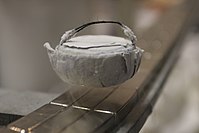
Photo from wikipedia
High-temperature superconductivity emerges in many different quantum materials, often in regions of the phase diagram where the electronic kinetic energy is comparable to the electron-electron repulsion. Describing such intermediate-coupling regimes… Click to show full abstract
High-temperature superconductivity emerges in many different quantum materials, often in regions of the phase diagram where the electronic kinetic energy is comparable to the electron-electron repulsion. Describing such intermediate-coupling regimes has proven challenging as standard perturbative approaches are inapplicable. Here, we employ quantum Monte Carlo methods to solve a multiband Hubbard model that does not suffer from the sign problem and in which only repulsive interband interactions are present. In contrast to previous sign-problem-free studies, we treat magnetic, superconducting, and charge degrees of freedom on an equal footing. We find an antiferromagnetic dome accompanied by a metal-to-insulator crossover line in the intermediate-coupling regime, with a smaller superconducting dome appearing in the metallic region. Across the antiferromagnetic dome, the magnetic fluctuations change from overdamped in the metallic region to propagating in the insulating region. Our findings shed new light on the intertwining between superconductivity, magnetism, and charge correlations in quantum materials.
Journal Title: Physical review letters
Year Published: 2020
Link to full text (if available)
Share on Social Media: Sign Up to like & get
recommendations!